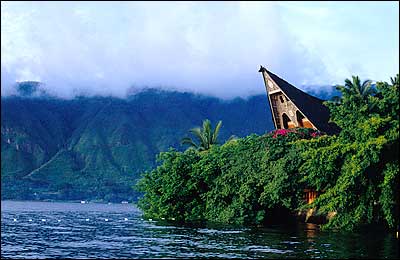The Exotic Wanderer

Premed student Gabe Struck comes from a long line of global travelers. His grandfather traversed West Africa and Asia; his father served in the Peace Corps in Tunisia; his aunt, a USAID worker, flies to developing countries every few weeks. Though just 25 years old, Struck has an adventure-travel CV that already includes eating freshly slain leopard meat in the Cambodian jungle, saving a Kiwi from spider-venom poisoning in Bulgaria, and drinking fermented horse’s milk with Mongolian nomads. “I guess I just love unspoiled, middle-of-nowhere places,” he says.
The Trip

Volcanic Lake Toba.Photograph by Jeff Yates/Lonely Planet Images
Granted, if you were forced to compose an entry for a Most Perverse Vacation contest, travel to Sumatra in 2005 might well make the cut. We all know that the crusty geographic plates beneath the Indian Ocean, on Sumatra’s west coast, have been doing some nasty jiggling lately. The December 26 tsunami-spawning temblor registered 9.3 on the Richter scale—the second most severe earthquake since such measurements began. The March 28 follow-up—whose death toll was a merciful fraction of that of the prior quake—tallied a bracing 8.7.
Of course, skittish travelers already had plenty of excuses to sidestep Indonesia—civil strife in the northern province of Aceh, terrorist bombings on Java and Bali. Those of us with a penchant for out-of-the-way gems, however, are rarely deterred—and may even be egged on—by such developments. Indeed, New Yorkers are in a particularly good position to know the moral, and economic, boost that the presence of hardy tourists can offer those living in the wake of terrible fortune. You will not hear it on the TV news, but Sumatra—a California-size marvel of beaches, jungles, and mountains at the top of the Indonesian archipelago—remains spectacularly beautiful, culturally fascinating, and overwhelmingly friendly. And, ironically enough, the same tectonic forces that produced the recent calamities were responsible, in a much earlier outburst, for creating the single most magical spot I’ve ever visited. How cool can a destination be? Well, this one is located inside a volcano, its cuisine is centered on tempeh, and its major village is called—no joking, and, please, no punning—Tuk Tuk.
The approach to Tuk Tuk begins 110 miles away in coastal Medan, a mildewed Dutch colonial outpost with the air quality of a bus depot. A narrow winding road, crowded with broken-down oxcarts and sputtering Eisenhower-era vehicles, climbs out of the lowlands. The hillsides grow thick with jungle foliage, and the road is shaded by a neon profusion of fruit trees that yield softball-size mangoes and the weird, hairy clusters of a delicacy called rambutan. Halfway to Tuk Tuk, you might opt, as I did, to spend a day or two in the formerly grand mountain resort town of Berastagi, where there are fabulous hiking possibilities on a pair of locally sacred volcanoes, their peaks mystically swathed in smoky sulfur. (Virgins, be warned.)
Onward to Tuk Tuk, the road continues to rise. At its high point, you are granted a sudden and shocking view into an enormous, steep-sided bowl, at the bottom of which are the pristine waters of Lake Toba, about 60 miles long and 20 miles wide, Southeast Asia’s largest freshwater pool. At this vantage point, you are perched on the lip of the crater left behind by the eruption, 75,000 years ago, of what is thought to have been the world’s last “super-volcano.” Sound sexy? The Toba explosion was 3,000 times as powerful as that of Mount St. Helens, and a clutch of reputable scientists speculate that it caused the last ice age and destroyed most life on the planet. Most important, the cataclysm left behind a prime vacation spot.
You descend to the bottom of the crater, then take an hour-long ferry trip to Samosir Island, in the middle of the lake. Samosir, roughly ten times the size of Manhattan, is occupied by a few thousand scattered residents—rice farmers, water-buffalo herders—and a few dozen blissed-out travelers, who cluster in the peninsular tourist hub of Tuk Tuk. Three thousand feet above sea level, Tuk Tuk is a sun-drenched 80 degrees year-round, its shore lined with thatch-roofed cottages and a couple of low-slung hotels. (The most upscale choice, Carolina’s Hotel, might set you back $30 per night.) The prevailing vibe is tropical bohemian—laid-back and tolerant without being sleazy. The services are appropriately basic—no golf courses or Jet Skis, though you will find Internet access and DVDs. Fresh curries and stir-fry rule; nasi goreng—the Indonesian staple of fried rice topped with an egg—is a daily requirement.
The other daily requirements are these: swimming, biking, wandering. The lake, tinted aquamarine, averages 1,500 feet in depth and is so clear you’ll think you can see to the bottom. Floating in those waters, surrounded by the green forested walls of the crater, is an experience of relaxation so complete as to make you check your tea bag for narcotics. (None there.) To explore the island, rent a bike or a scooter to tackle the single, cruelly potholed paved road, or set out on foot. There’s no wrong direction to go. I tried to climb the unnamed mountain at the center of the island but turned back when the path was obscured by dense undergrowth.
No great loss. The richest sights are those afforded by glimpses of the lives of Samosir’s residents. These islanders, descendants of the Toba Batak natives, live in villages made up of a ring of traditional houses: loftlike spaces, resting on stilts and covered by sharply sloping thatch roofs. Each house, shared by several families, is decorated with talismanic carvings and offers shelter for livestock beneath its raised floors. No doubt a wood-carver will invite you into his workshop and try to sell you his handiwork. Buy some. The carvings are beautiful and cheap. You might also see women, in bright silk garments, rehearsing a trancelike traditional dance. Villagers have a custom of greeting curiosity seekers with a lustily shouted greeting, “Horas!” The polite response is to return the sentiment. You are, after all, dropping in on their paradise—one that persists, and thrives, miraculously, in the shadow of disaster.
A $35 visa is required for travel to Indonesia; for information regarding travel safety in Indonesia, call 888-407-4747 or go to travel.state.gov. British Airways as well as Singapore, Malaysia, and United airlines all fly to Medan out of New York. Bukit Kubu Hotel in Berastagi (from about $50; 62-628-91533). Carolina’s Hotel (from about $15; 62-625-41520) rents bikes and scooters by the day (about $3 or $4 for a bike).